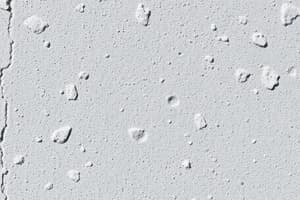Podcast
Questions and Answers
What is the primary purpose of heavyweight concrete?
What is the primary purpose of heavyweight concrete?
- Nuclear radiation shielding (correct)
- Used for structural strength in buildings
- Insulating purposes in construction
- Cost-effective construction modifications
Which type of concrete is typically used in the construction of dams?
Which type of concrete is typically used in the construction of dams?
- Mass concrete (correct)
- Refractory concrete
- Normal-weight concrete
- Lightweight insulating concrete
What does the term 'jointing' refer to in concrete construction?
What does the term 'jointing' refer to in concrete construction?
- Placing premolded inserts to control cracking (correct)
- Creating a rough texture for better adhesion
- The process of leveling a slab surface
- A method to finish the surface of the concrete
What is the result of bleeding in concrete?
What is the result of bleeding in concrete?
Which of the following best describes screeding?
Which of the following best describes screeding?
How does refractory concrete differ from regular concrete?
How does refractory concrete differ from regular concrete?
What is the main purpose of leveling in concrete work?
What is the main purpose of leveling in concrete work?
What does edging involve in the context of concrete work?
What does edging involve in the context of concrete work?
What is the primary cause of a seiche phenomenon?
What is the primary cause of a seiche phenomenon?
Which of the following signs is intended to warn users about temporary hazardous conditions?
Which of the following signs is intended to warn users about temporary hazardous conditions?
What is the effect of a retarder in concrete mixing?
What is the effect of a retarder in concrete mixing?
What does grade resistance represent in vehicle dynamics?
What does grade resistance represent in vehicle dynamics?
Which of the following accurately describes the perception time for a driver?
Which of the following accurately describes the perception time for a driver?
What does the term 'heaped volume' refer to in the context of bucket capacity?
What does the term 'heaped volume' refer to in the context of bucket capacity?
In concrete mixing, what role does an admixture play?
In concrete mixing, what role does an admixture play?
What does the term 'water line capacity' signify regarding a bucket?
What does the term 'water line capacity' signify regarding a bucket?
What defines a natural harbor?
What defines a natural harbor?
Which component is primarily responsible for rolling resistance?
Which component is primarily responsible for rolling resistance?
What is the primary purpose of a wharf?
What is the primary purpose of a wharf?
What does a prime coat involve in road construction?
What does a prime coat involve in road construction?
Which of the following accurately describes a jetty?
Which of the following accurately describes a jetty?
What is the primary function of guide signs?
What is the primary function of guide signs?
Which of the following terms refers to the chemical reaction between cement and water?
Which of the following terms refers to the chemical reaction between cement and water?
What term is used to describe the highest wave in a wave group?
What term is used to describe the highest wave in a wave group?
Which definition applies to 'Mean Low Water'?
Which definition applies to 'Mean Low Water'?
What is the impact of a water-reducing agent in concrete mixing?
What is the impact of a water-reducing agent in concrete mixing?
What characteristic defines a regulatory traffic sign?
What characteristic defines a regulatory traffic sign?
What is a dolphin in maritime terms?
What is a dolphin in maritime terms?
What does the term 'Storm Surge' refer to?
What does the term 'Storm Surge' refer to?
Which of the following describes a deepwater wave?
Which of the following describes a deepwater wave?
Flashcards
Concrete
Concrete
A construction material made by combining Portland cement, aggregate, and water.
Normal-weight concrete
Normal-weight concrete
Concrete weighing between 140-160 lb/cu.ft.
Lightweight insulating concrete
Lightweight insulating concrete
Concrete weighing 15-90 lb/cu.ft. with a 28-day compressive strength of 100-1000 psi.
Mass concrete
Mass concrete
Signup and view all the flashcards
Heavyweight concrete
Heavyweight concrete
Signup and view all the flashcards
Refractory concrete
Refractory concrete
Signup and view all the flashcards
Leveling (concrete)
Leveling (concrete)
Signup and view all the flashcards
Edging (concrete)
Edging (concrete)
Signup and view all the flashcards
Screeding (concrete)
Screeding (concrete)
Signup and view all the flashcards
Jointing (concrete)
Jointing (concrete)
Signup and view all the flashcards
Bleeding (concrete)
Bleeding (concrete)
Signup and view all the flashcards
Troweling (concrete)
Troweling (concrete)
Signup and view all the flashcards
Scaling (concrete)
Scaling (concrete)
Signup and view all the flashcards
Harbor
Harbor
Signup and view all the flashcards
Natural Harbor
Natural Harbor
Signup and view all the flashcards
Artificial Harbor
Artificial Harbor
Signup and view all the flashcards
Port
Port
Signup and view all the flashcards
Fairway
Fairway
Signup and view all the flashcards
Wharf
Wharf
Signup and view all the flashcards
Pier
Pier
Signup and view all the flashcards
Jetty
Jetty
Signup and view all the flashcards
Dolphin
Dolphin
Signup and view all the flashcards
Significant Wave
Significant Wave
Signup and view all the flashcards
Highest Wave
Highest Wave
Signup and view all the flashcards
Mean Wave
Mean Wave
Signup and view all the flashcards
Deepwater Waves
Deepwater Waves
Signup and view all the flashcards
Mean Sea Level
Mean Sea Level
Signup and view all the flashcards
Mean Low Water
Mean Low Water
Signup and view all the flashcards
Mean Lower Low Water
Mean Lower Low Water
Signup and view all the flashcards
Storm Surge
Storm Surge
Signup and view all the flashcards
Tsunami
Tsunami
Signup and view all the flashcards
Seiche
Seiche
Signup and view all the flashcards
Seal coat
Seal coat
Signup and view all the flashcards
Tack coat
Tack coat
Signup and view all the flashcards
Prime coat
Prime coat
Signup and view all the flashcards
Perception time
Perception time
Signup and view all the flashcards
Intellection time
Intellection time
Signup and view all the flashcards
Emotion time
Emotion time
Signup and view all the flashcards
Volition time
Volition time
Signup and view all the flashcards
Traffic sign
Traffic sign
Signup and view all the flashcards
Regulatory sign
Regulatory sign
Signup and view all the flashcards
Warning sign
Warning sign
Signup and view all the flashcards
Guide sign
Guide sign
Signup and view all the flashcards
Roadwork sign
Roadwork sign
Signup and view all the flashcards
Overhead sign
Overhead sign
Signup and view all the flashcards
Plate line capacity
Plate line capacity
Signup and view all the flashcards
Struck capacity
Struck capacity
Signup and view all the flashcards
Water line capacity
Water line capacity
Signup and view all the flashcards
Heaped volume
Heaped volume
Signup and view all the flashcards
Grade resistance
Grade resistance
Signup and view all the flashcards
Rolling resistance
Rolling resistance
Signup and view all the flashcards
Total resistance
Total resistance
Signup and view all the flashcards
Aggregate
Aggregate
Signup and view all the flashcards
Water (concrete)
Water (concrete)
Signup and view all the flashcards
Hydration
Hydration
Signup and view all the flashcards
Water-reducing agent
Water-reducing agent
Signup and view all the flashcards
Retarder
Retarder
Signup and view all the flashcards
Accelerator
Accelerator
Signup and view all the flashcards
Pozzolan
Pozzolan
Signup and view all the flashcards
Plasticizers
Plasticizers
Signup and view all the flashcards
Batching
Batching
Signup and view all the flashcards
Admixture
Admixture
Signup and view all the flashcards
Study Notes
Concrete
- A construction material made from Portland cement, aggregate, and water
- Normal-weight concrete typically weighs 140-160 lb/cu ft
- Lightweight insulating concrete weighs 15-90 lb/cu ft and has a 28-day compressive strength of 100-1000 psi
- Mass concrete used in structures like dams, where the weight provides strength
- Heavyweight concrete use heavy aggregates (barite, magnetite, steel) for radiation shielding
- Refractory concrete is cast into the desired shape before placement.
- Leveling refers to achieving the correct grade with mortar
- Edging rounds off slab edges to prevent chipping
- Screeding moves a straight edge across freshly placed concrete
- Jointing uses preformed inserts to control cracking due to shrinkage
- Bleeding is the settling of dry materials to the bottom of concrete, displacing water
- Troweling is the process of smoothing surfaces with a tool
- Scaling is the breaking away of hardened concrete surface (1/6-3/16 inch depth) usually in early age of the slab
Harbor Terms
- A protected water area for ships (loading, unloading, repairs, etc.)
- Natural harbors are protected by natural land formations
- Artificial harbors are protected by breakwaters or dredging
- Port is a sheltered place for cargo loading/unloading
- Fairway is a navigable channel for ships
- Wharf is a structure parallel to water for cargo handling
- Pier is a landing stage, jetty, floating barge, or pontoon
- Jetty is a structure extending into the sea
- Dolphin is a berth structure for mooring ships
- Significant wave is the hypothetical wave with the average height/period of a group
- Highest wave is the tallest wave in a wave group
- Mean wave is the wave with average height/period of a wave group
Water Terms
- Deepwater waves are where the water depth is at least half the wavelength
- Mean Sea Level is the average of sea water level for a period of 19 years
- Mean Low Water is the height of low water over a 19-year period
- Mean Lower Low Water is the average height of lower low waters over 19 years
- Storm Surge is a temporary rise in sea level due to pressure reduction caused by storms and wind
- Tsunamis are waves with long periods, often caused by significant sea floor movements
- Seiche is a phenomenon of water oscillation with periods of a few minutes to tens of minutes
- Seal coat is a thin bituminous surface treatment
- Tack coat is an initial bituminous application
- Prime coat is a bituminous application on a prepared surface
- Perception time is the time for a driver to realize the need for braking
- Intellection time is the time to understand a situation and consider options
- Emotion time is the time for emotional response to a situation
- Volition time is the time taken for the final action
Traffic Terms
- Traffic sign is a device conveying information for regulating, warning, or guiding traffic
- Regulatory signs inform drivers of traffic laws
- Warning signs alert drivers of road conditions
- Guide signs show directions, distances, and routes
- Roadwork signs provide information about roadwork
- Overhead signs display traffic information on wide roads
- Plate line capacity is the volume of a bucket when the load is struck off
- Struck capacity is the bucket volume when the load is struck
- Water line capacity is a level of material within the bucket
- Heaped volume is maximum placement in a bucket without spillage
- Grade resistance is the vehicle weight component parallel to the inclined surface
- Rolling resistance is due to tire flexing/penetration of the travel surface
- Total resistance is the combination of grade & rolling resistance
- Aggregate is concrete material to reduce cost and shrinkage
- Water is required in concrete for hydration of cement
- Hydration is the chemical reaction between cement and water to produce hardened cement
- Water-reducing agent increases workability and consistency in concrete without altering amount of water
Other Construction Terms
- Retarder slows concrete hardening
- Accelerator decreases setting time, increases early strength
- Pozzolan reduces heat of hydration, increases workability, and reduces segregation
- Plasticizers increase concrete workability
- Batching is the process of proportioning concrete ingredients.
- Admixture is any material added to concrete besides cement, aggregates, and water, altering its properties in various ways
Studying That Suits You
Use AI to generate personalized quizzes and flashcards to suit your learning preferences.




